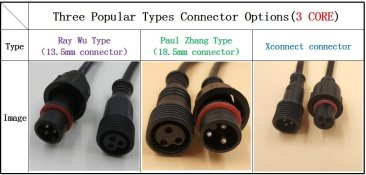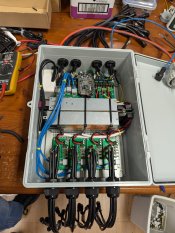Hi All
I've been into the Christmas light hobby the past few years as have 3 little ones (plus myself) that get a kick out of it. The street gets into it a little bit too, and it's slowly been escalating... I have lots of lights from the big green shed and online, but this year I'm looking to add my first pixel lights.
I wanted to put up a 180 degree megatree, somewhere between 2.5 - 3m tall. I was wanting to put some scrolling text across it, and maybe some images. From my reading, looking at 24 strings 50 nodes.
I've read through the manual a couple of times, done a bit of light research, and put together a small bill of material so I can budget accurately and then bite the bullet. Was hoping I could get a pair of eyes on it from seasoned veterans, and then had a few questions to follow.
Some questions:
1. Will the single PSU be underpowered for my requirements, by my calcs .24W per pixel, 12W per 50 string = 12W * 27 strings = 324W max, plus the boards themselves will have some nominal draw?
2. Is it feasible the external box shall fit everything, if not are there better options?
3. Should I account for some fan venting or will drilling some holes be sufficient in the external box.
4. For the star, it seems I would need to customize and cut the strings, Are there any other materials or tools I need for that type of work?
5. Excluding the tree mechanical structure, do I need to procure any additional items, eg
- GPO power plug for PSU
- wiring for PSU > controller
6. Please do let me know if what I am looking at is also overspecced or unnecessary to spend or do.
7. I live in WA in the northern suburbs (Jindalee), if there was anyone willing in that area to have me visit for half hour and ask some silly questions and look at their setup, I would appreciate it greatly!
Anyway looking forward to some feedback and any suggestions.
Thanks
SM
I've been into the Christmas light hobby the past few years as have 3 little ones (plus myself) that get a kick out of it. The street gets into it a little bit too, and it's slowly been escalating... I have lots of lights from the big green shed and online, but this year I'm looking to add my first pixel lights.
I wanted to put up a 180 degree megatree, somewhere between 2.5 - 3m tall. I was wanting to put some scrolling text across it, and maybe some images. From my reading, looking at 24 strings 50 nodes.
I've read through the manual a couple of times, done a bit of light research, and put together a small bill of material so I can budget accurately and then bite the bullet. Was hoping I could get a pair of eyes on it from seasoned veterans, and then had a few questions to follow.
| Function | Part | Description | Shop | Quantity | Cost per item | Total Cost |
| Controller | HE123 Mk2 16-48 output pixel board | E1.31 Pixel Controller - 16 fuses only | Hanson Electronics | 1 | 120 | 120 |
| Scheduler | BeagleBone Black | Hanson Electronics | 1 | 97 | 97 | |
| External Box | Waterproof Box-290x190x140 dimensions 290*190*140mm | Hanson Electronics | 1 | 34 | 34 | |
| External Box glands | 4 hole gland | Hanson Electronics | 3 | 2.8 | 8.4 | |
| Tooling | Pixel pliers | Hanson Electronics | 1 | 12 | 12 | |
| Sundry | M2.5x18 standoff kit | Hanson Electronics | 1 | 2.3 | 2.3 | |
| Sundry | M3x25 standoff kit | Hanson Electronics | 1 | 2.5 | 2.5 | |
| Sundry | M3x8 Screw (Pk10) | Hanson Electronics | 1 | 1 | 1 | |
| Sundry | M2.5x8 Screw (Pk10) | Hanson Electronics | 1 | 1 | 1 | |
| Mounting Strip | Pixel Mounting strip (50m roll) | Hanson Electronics | 2 | 125 | 250 | |
| Sundry | 3 core waterproof 13.5mm 40cm femail pigtails (pk 5) | Hanson Electronics | 2 | 10 | 20 | |
| Pixel Light pigtails | HE123 > Lights, 10 pack | 1 Metre | Ray wu Aliexpress | 1 | 15.49 | 15.49 |
| Pixel Light | 4inch spacing DC12V/50pcs/strand/bullet resistor type/RGB addressable WS2811 led pixel node 18AWG IP68 0.24w | order xconnect 24 for tree 3 for star http://spikerlights.com/calcpower.aspx - 4 nodes per string/fuse | Ray wu Aliexpress | 27 | 12.29 | 331.83 |
| Pixel Light pigtails | xConnect type BLACK round 18AWG 3 core waterproof femaile 1M long | 10 pieces | Ray wu Aliexpress | 1 | 15.49 | 15.49 |
| Pixel Light Shipping | Ray Wu shipping | Ray wu Aliexpress | 1 | 189.45 | 189.45 | |
| Power Supply | Meanwell LRS-350-12 dimensions 215*115*30mm | RS online | 1 | 65 | 65 | |
| Software | FPP 6 software | Falconchristmas.com | 1 | 80 | 80 | |
| Chromastar | Chromastar 36 3 ring kit 150 nodes | Extremelightingdisplays.com.au | 0 | |||
| Chromastar | Chromastar 23inch 59cm 3 ring kit 40-30-20 nodes ring | https://www.extremelightingdisplays.com.au/sku/star23/ | Extremelightingdisplays.com.au | 1 | 35 | 35 |
| Network Switch | Existing Cisco 3750x Guest VLAN/FW segment | NA | 0 | |||
| Megatree topper | Small 48 hole | https://piptree-designs-108285.squa...true&sa=false&sbp=false&q=false&category_id=4 | Piptree | 1 | 71.5 | 71.5 |
1351.96 |
Some questions:
1. Will the single PSU be underpowered for my requirements, by my calcs .24W per pixel, 12W per 50 string = 12W * 27 strings = 324W max, plus the boards themselves will have some nominal draw?
2. Is it feasible the external box shall fit everything, if not are there better options?
3. Should I account for some fan venting or will drilling some holes be sufficient in the external box.
4. For the star, it seems I would need to customize and cut the strings, Are there any other materials or tools I need for that type of work?
5. Excluding the tree mechanical structure, do I need to procure any additional items, eg
- GPO power plug for PSU
- wiring for PSU > controller
6. Please do let me know if what I am looking at is also overspecced or unnecessary to spend or do.
7. I live in WA in the northern suburbs (Jindalee), if there was anyone willing in that area to have me visit for half hour and ask some silly questions and look at their setup, I would appreciate it greatly!
Anyway looking forward to some feedback and any suggestions.
Thanks
SM



